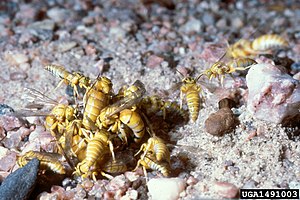Bembecinus
| Bembecinus | ||||||||||||
|---|---|---|---|---|---|---|---|---|---|---|---|---|

Bembecinus quinquespinosus |
||||||||||||
| Systematics | ||||||||||||
|
||||||||||||
| Scientific name | ||||||||||||
| Bembecinus | ||||||||||||
| A. Costa , 1859 |
Bembecinus is a genus of digger wasps (Spheciformes) from the Crabronidae family. The genus includes around 150 species that are mainly found in the Ethiopian region. 31 species are distributed inthe Palearctic , 10 species are found in Europe and two are also found in Germany. In the older literature the species is combined with the genus Stizus or this with Bembecinus .
features
Characteristic are the compound eyes that converge downwards and protrude like a strip. The posterior lateral corners of the pronotum are often notched.
Way of life
The females create their simple nests in the ground. At the end of a tube up to 20 centimeters long there is usually one, rarely two cells. Unlike other digger wasps, the eggs are laid in the empty cell. For this purpose, a small, one to two millimeter high and twice as wide bump made of sand is created in the middle of the cell. The 2.5 to 3.0 millimeter long egg is then glued to this elevation with the slightly wider end. The female does not return to the nest until at least 24 hours after the egg has been laid and begins with the provisioning. The larvae hatch two days after the eggs are laid. The brood is supplied with cicadas, which are stunned or killed by a sting with the poison. They are transported to the nest in flight and held in place with the middle pair of legs. The female lands directly at the nest entrance, digs it free and pulls the prey into the nest. The first two animals are placed with their belly up and their head down on both sides of the egg. The hatched larva lies on its side and then begins to feed on the cicadas' abdomen. Only on the following day does the larva move around in the cell, the female then brings further cicadas into the nest. When the larva is half developed, the cell is completely filled and is closed by the female. The development is already complete about six days after the egg is laid.
Unusually for digger wasps, the animals do not sleep in the ground, but in sometimes large sleeping communities on plants. Depending on the species, up to 1000 animals can cluster together. However, these clusters presumably only contain unfertilized females, since fertilized ones spend the night in their nest.
Species (Europe)
- Bembecinus carinatus Lohrman 1942
- Bembecinus carpetanus (Mercet 1906)
- Bembecinus crassipes (Handlirsch 1895)
- Bembecinus cyprius Beaumont 1954
- Bembecinus hungaricus (Frivaldszky 1876)
- Bembecinus insulanus Beaumont 1954
- Bembecinus meridionalis A. Costa 1859
- Bembecinus peregrinus (F. Smith 1856)
- Bembecinus pulchellus (Mercet 1906)
- Bembecinus tridens (Fabricius 1781)
supporting documents
Individual evidence
- ↑ a b c d e Manfred Blösch: The digger wasps in Germany: way of life, behavior, distribution . 1st edition. Goecke & Evers, 2000, ISBN 3-931374-26-2 , pp. 390 .
- ↑ Bembecinus. Fauna Europaea, accessed July 23, 2010 .
literature
- Manfred Blösch: The digger wasps in Germany: way of life, behavior, distribution . 1st edition. Goecke & Evers, 2000, ISBN 3-931374-26-2 .